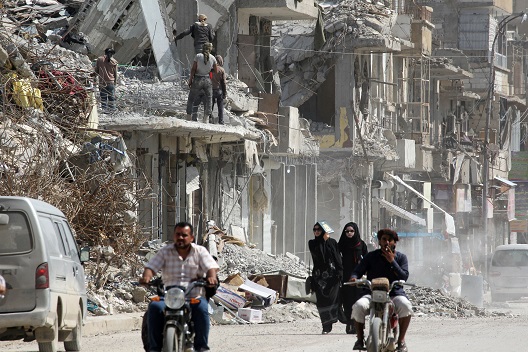 On June 5, 2018 Amnesty International issued a report entitled “War of Annihilation:” Devastating Toll on Civilians, Raqqa – Syria. A shockingly painful account of the experiences of four Syrian families during the June-October 2017 military campaign to oust ISIS (ISIL, Daesh, Islamic State, IS) from its self-declared “capital” in Syria, the report (based largely on a February 2018 on-site investigation) alleges that the anti-ISIS Coalition took insufficient steps to protect civilians. Specifically:
On June 5, 2018 Amnesty International issued a report entitled “War of Annihilation:” Devastating Toll on Civilians, Raqqa – Syria. A shockingly painful account of the experiences of four Syrian families during the June-October 2017 military campaign to oust ISIS (ISIL, Daesh, Islamic State, IS) from its self-declared “capital” in Syria, the report (based largely on a February 2018 on-site investigation) alleges that the anti-ISIS Coalition took insufficient steps to protect civilians. Specifically:
Coalition claims that its precision air campaign allowed it to bomb IS out of Raqqa while causing very few civilian casualties do not stand up to scrutiny. Based on information from Amnesty International’s field investigation and public reporting, Coalition air and artillery strikes killed hundreds of civilians and injured many more. The Coalition strikes detailed in this report appear either disproportionate or indiscriminate or both and as such unlawful and potential war crimes. The cases documented here, provide an example of a wider pattern, raise serious concerns and should be thoroughly and independently investigated. Mistakes must be acknowledged, causes analysed and lessons learned.
This writer cannot substantiate the report or the US Department of Defense’s rejection of its findings. Amnesty International has, over the years, issued several reports detailing Russian and Assad regime crimes against humanity in the Syrian conflict: reports presumably read and internalized by American officials. No doubt it is painful and infuriating for American defense officials to have the performance of American military personnel, at least in the case of Raqqa, put on roughly the same ethical plane as the performance of Syrian and Russian militaries.
Indeed, those professional ethics are not the same. Syrian and Russian pilots deliberately target civilians, the aim being to terrorize survivors into rejecting armed rebels in their midst. Amnesty International makes no such accusation against American, French, or British pilots.
Still, as one reads the heart-breaking stories of four families trying to flee ISIS-controlled areas, only to be subjected to massed artillery fires and airstrikes destroying buildings along with the civilians inhabiting them, one inevitably asks whether the intent of pilots and artillerymen makes any practical difference to those on the receiving end.
The American response to the report rightly cites the ISIS tactic of hiding behind civilians. It also stresses what it describes as a rigorous intelligence collection effort educating the targeting process. None of this inspires reflexive disbelief. And yet: what was the provenance of the targeting intelligence? What is the Department of Defense doing in terms of rigorous, brutally honest, and (if necessary) self-critical after-action investigation consistent with professional standards that have always mandated the accurate cataloguing of “lessons learned?”
During the battle against ISIS in Syria, this writer has questioned and criticized the Coalition’s use of a militia as its ground combat force component. Neutralizing ISIS quickly, before it could use Raqqa to plan and execute deadly terror operations abroad (as it eventually did), required a professional ground combat coalition-of-the-willing, led by the United States. Nearly four years into militia ground combat operations, ISIS is still not totally suppressed.
Sadly, the Obama administration decided that a militia would be good enough; sufficient even for operating in a complex urban environment, one packed with civilians. This callous arrangement was, over time, dressed up with language describing the American-led Coalition as the “supporting force” for “indigenous” people fighting ISIS occupation. It was even hailed by some as a new template for modern warfare, one that could minimize American casualties by relying on locals to do the heavy combat lifting.
But was this militia properly trained in urban warfare techniques to kill the enemy while minimizing civilian casualties? Did it have the requisite target acquisition skills to communicate accurately with Coalition air assets, so that ISIS could be hit with minimal collateral casualties? If it did not have those skills, were there trained Western professionals embedded with the militia to acquire targets properly?
Fighting in Raqqa stopped in October 2017. Some ISIS fighters were given free passage out, while Syrian civilians were left to locate their dead, bury them, and try to sustain themselves with few resources in a devastated city littered with landmines. Ten months later Raqqa remains in a state of wreckage.
One may reject totally the Amnesty International Report—its methodology, its findings, and its recommendations—and still feel, as an American, a profound sense of obligation to organize (with the help of allies) the rapid reconstruction of this city and the rehabilitation of its inhabitants. This would be the centerpiece of stabilizing northeastern Syria to seal the victory over ISIS. Operational lessons learned from the Raqqa campaign can be defined and internalized in parallel.
This is not an expiation. It is the taking of responsibility. It is demonstrating leadership. It is behaving in a manner consistent with our self-image as Americans and the national security interests of the United States in Syria and far beyond.
Frederic C. Hof is a faculty member of Bard College and a nonresident senior fellow of the Atlantic Council’s Rafik Hariri Center for the Middle East.
Image: Photo: Women walk past rubble of damaged buildings in Raqqa, Syria May 14, 2018. REUTERS/Aboud Hamam/File Photo
